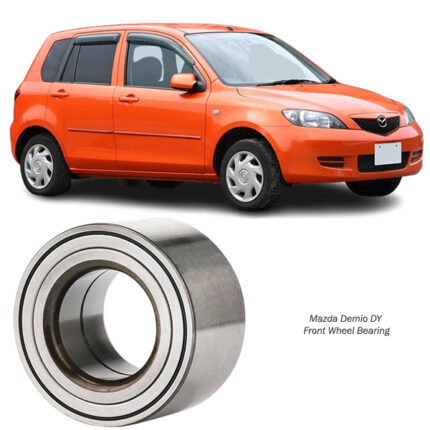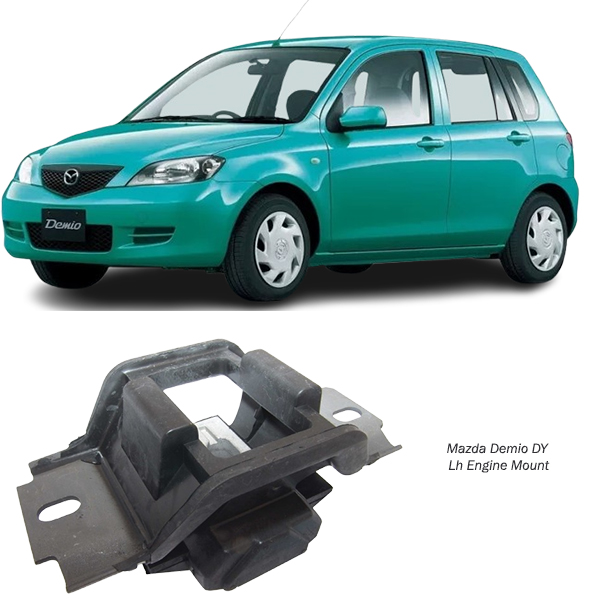-13%
Get Mazda Demio DY LH Insulator Engine Mount D350-39-070C in Kenya
The insulator engine mount, often referred to simply as the engine mount, is a critical component of a vehicle’s drivetrain system. It serves as a bridge between the engine and the vehicle’s chassis, ensuring the smooth operation of the engine while minimizing vibrations and noise. This article explores the design, function, types, benefits, maintenance, and troubleshooting of insulator engine mounts in detail.
1. The Function of an Insulator Engine Mount
a) Structural Support
The engine mount holds the engine securely in place within the engine bay, ensuring it remains aligned and stable during vehicle operation.
b) Vibration and Noise Dampening
The mount is equipped with rubber or other insulating materials to absorb engine vibrations and reduce the transmission of noise to the cabin.
c) Flexibility for Movement
While it stabilizes the engine, the mount allows slight movement to accommodate engine torque and vibrations without damaging the chassis.
d) Load Distribution
Engine mounts help distribute the engine’s weight evenly across the chassis, preventing undue stress on other vehicle components.
2. Construction and Design of Engine Mounts
a) Basic Structure
- Metal Bracket: Provides a strong connection point between the engine and the chassis.
- Insulating Material: Typically made of rubber, polyurethane, or liquid-filled chambers to absorb vibrations.
- Fasteners: Bolts and nuts secure the mount to the engine and the chassis.
b) Advanced Designs
- Hydraulic Engine Mounts: Filled with a liquid or gel to provide enhanced vibration dampening.
- Electronic Engine Mounts: Equipped with actuators or sensors to adjust stiffness based on driving conditions.
3. Types of Insulator Engine Mounts
The type of engine mount used depends on the vehicle’s design and performance requirements.
a) Rubber Engine Mounts
- Made of durable rubber for basic vibration isolation.
- Common in budget-friendly vehicles.
b) Hydraulic Engine Mounts
- Use a fluid-filled chamber for superior noise and vibration isolation.
- Ideal for luxury and high-performance vehicles.
c) Active Engine Mounts
- Feature sensors and actuators to adjust stiffness dynamically.
- Found in modern vehicles with advanced drivetrains.
d) Polyurethane Engine Mounts
- Durable and resistant to wear, commonly used in sports and off-road vehicles.
4. Benefits of Insulator Engine Mounts
a) Improved Ride Comfort
Engine mounts minimize the transmission of engine noise and vibrations, creating a smoother driving experience.
b) Enhanced Engine Stability
By securely holding the engine in place, mounts prevent excessive movement that could damage surrounding components.
c) Increased Longevity of Components
A stable engine reduces wear on associated parts like the exhaust system, transmission, and driveshafts.
d) Better Handling and Performance
Well-functioning mounts improve vehicle stability, especially during acceleration, cornering, or braking.
e) Noise Reduction
Advanced mounts, such as hydraulic or active types, provide significant noise dampening for a quieter cabin.
5. Signs of a Failing Engine Mount
Timely identification of a failing mount can prevent damage to the engine and other components.
a) Excessive Vibrations
A damaged mount loses its insulating properties, resulting in noticeable vibrations in the cabin.
b) Clunking or Banging Noises
A loose or broken mount allows the engine to move excessively, causing noises when shifting gears or driving over bumps.
c) Engine Misalignment
The engine may appear tilted or out of place within the engine bay.
d) Increased Noise Levels
Faulty mounts fail to dampen engine noise, leading to a louder cabin environment.
e) Visible Wear or Damage
Cracked rubber, leaks in hydraulic mounts, or corroded metal brackets are signs of wear.
6. Maintenance and Care of Engine Mounts
Proper care ensures the longevity and performance of insulator engine mounts.
a) Regular Inspections
Check for visible wear, cracks, or leaks during routine maintenance.
b) Avoid Harsh Driving
Aggressive driving, hard braking, and sudden acceleration put extra strain on engine mounts.
c) Monitor Vibrations
Address unusual vibrations early to prevent damage to the mounts.
d) Replace When Necessary
Most engine mounts last between 50,000 to 100,000 miles, but replacement may be required earlier in some cases.
7. Replacing an Insulator Engine Mount
Replacing a faulty engine mount requires proper tools and expertise.
a) Tools Needed
- Jack and jack stands.
- Socket set and wrench.
- Pry bar and torque wrench.
b) Step-by-Step Process
- Secure the Vehicle: Park on a flat surface and use wheel chocks.
- Lift the Engine: Use a jack and a wooden block to support the engine.
- Remove the Old Mount: Loosen bolts and detach the mount from the engine and chassis.
- Install the New Mount: Align the new mount, secure it with bolts, and torque them to specifications.
- Test Drive: Check for smooth operation and absence of unusual noises or vibrations.
8. Troubleshooting Common Engine Mount Issues
a) Persistent Vibrations
- Cause: Misalignment during installation or a defective mount.
- Solution: Realign the mount or replace it if defective.
b) Premature Wear
- Cause: Harsh driving or low-quality mounts.
- Solution: Use high-quality mounts and adopt smoother driving habits.
c) Noise During Operation
- Cause: Loose bolts or worn insulating material.
- Solution: Tighten bolts or replace the mount.
9. Cost Considerations
The cost of replacing engine mounts depends on their type, quality, and vehicle model.
a) Material and Type
- Rubber mounts are more affordable but may wear faster.
- Hydraulic and active mounts are pricier but offer superior performance.
b) Labor Costs
- Professional replacement services cost more but ensure proper installation.
- DIY replacements are cost-effective but require tools and mechanical knowledge.
10. Engine Mounts in Modern Vehicles
Modern vehicles feature advanced engine mounts to meet the demands of sophisticated engines and drivetrains.
a) Compatibility with Electric Vehicles (EVs)
- EVs require specialized mounts to dampen vibrations from electric motors, which operate differently than combustion engines.
b) Integration with Advanced Systems
- Active mounts can adjust stiffness based on inputs from the vehicle’s computer, optimizing performance.
11. Environmental Impact
a) Eco-Friendly Materials
Manufacturers are exploring sustainable materials like recycled rubber for engine mounts.
b) Reduced Emissions
Efficient mounts improve engine performance, indirectly contributing to lower emissions.
12. Conclusion
The insulator engine mount is a small yet essential component that significantly impacts a vehicle’s performance, comfort, and longevity. Whether you’re driving a compact car or a high-performance vehicle, ensuring that your engine mounts are in good condition is critical for a smooth and safe driving experience. Regular inspections, timely replacements, and choosing the right type of mount for your vehicle can save costs and enhance overall vehicle performance.
Follow us on Facebook for more parts.




Reviews
Clear filtersThere are no reviews yet.